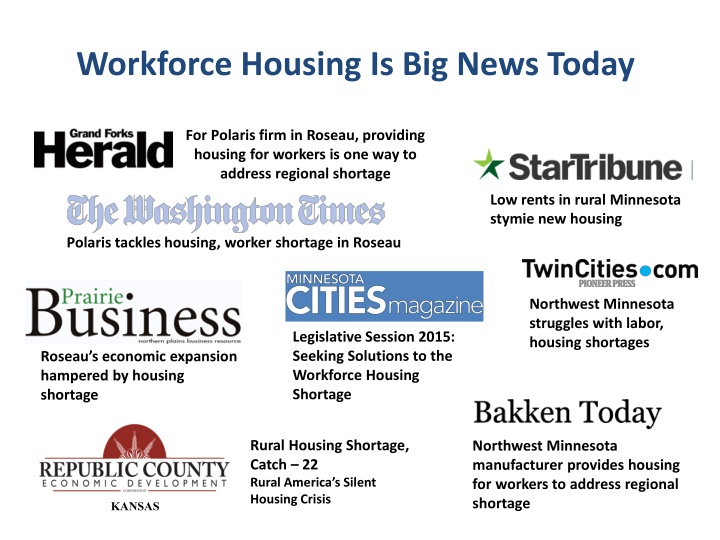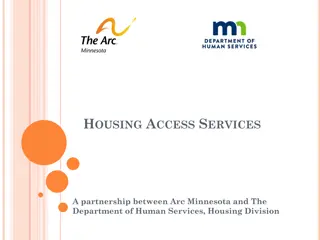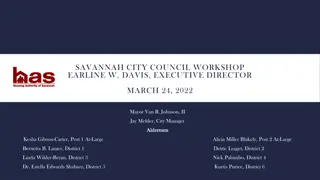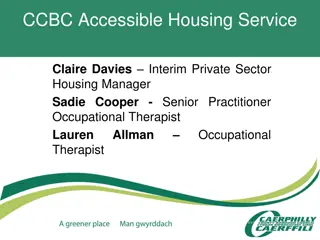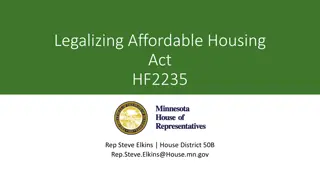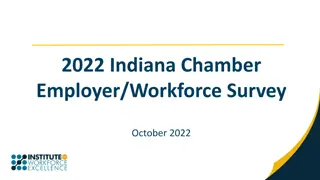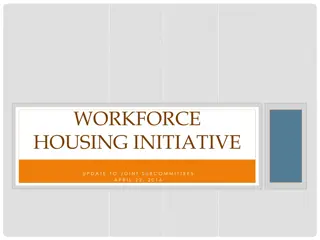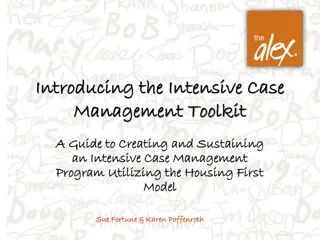Addressing Workforce Housing Shortage in Rural Minnesota
Workforce housing shortage in rural Minnesota, particularly in Roseau County, is hindering economic growth and attracting new employees. Local industry leaders are recognizing the challenges and exploring solutions to provide affordable housing for workers. Market studies indicate a significant demand for new rental and owner-occupied housing units by 2020. However, economic factors and low rental rates pose challenges for developers to meet this demand efficiently.
Download Presentation

Please find below an Image/Link to download the presentation.
The content on the website is provided AS IS for your information and personal use only. It may not be sold, licensed, or shared on other websites without obtaining consent from the author.If you encounter any issues during the download, it is possible that the publisher has removed the file from their server.
You are allowed to download the files provided on this website for personal or commercial use, subject to the condition that they are used lawfully. All files are the property of their respective owners.
The content on the website is provided AS IS for your information and personal use only. It may not be sold, licensed, or shared on other websites without obtaining consent from the author.
E N D
Presentation Transcript
Workforce Housing Is Big News Today For Polaris firm in Roseau, providing housing for workers is one way to address regional shortage Low rents in rural Minnesota stymie new housing Polaris tackles housing, worker shortage in Roseau Northwest Minnesota struggles with labor, housing shortages Legislative Session 2015: Seeking Solutions to the Workforce Housing Shortage Roseau s economic expansion hampered by housing shortage Rural Housing Shortage, Catch 22 Rural America s Silent Housing Crisis Northwest Minnesota manufacturer provides housing for workers to address regional shortage KANSAS
Insufficient Workforce Housing a major problem in Roseau County Local economy has rebounded from recession and significant hiring of new employees is occurring, many from outside of the Roseau County Local employers and new employees find rental housing harder and harder to obtain Adequate housing availability becomes a major factor in the ability to attract new employees for growing businesses across Roseau County and NW Minnesota Local industry and community leaders begin to discuss the issues surrounding the lack of housing for new employees and housing industry experts are brought into the discussion. The magnitude and causes of the housing shortage are not immediately understood.
2012 Roseau County Market Study Commissioned FINDINGS Rapidly declining unemployment rate in the County and heavy importation of new workers Extremely low vacancy rates for market rate rental housing (0-2%) with the addition of no new stock Low rental rates across the county with a median rental rate of $555 Projected demand for 153 new market rate rental units by 2020 Projected demand for 67 new affordable rental units by 2020 Projected demand for 147 new owner- occupied housing units by 2020
Market Not Meeting Workforce Housing Demand Premise: If there is such a strong demand for workforce housing, than developers will be attracted to supply new housing units to meet that demand. Reality: A multitude of economic factors in small rural communities lead to inefficiencies in the housing market, ultimately limiting the ability to supply new housing units to meet the growing workforce housing need.
Rural Housing Market Obstacles Small rural populations are limited markets (e.g. Apartment Complexes are general only efficiently constructed at 24 or more units a high threshold to meet for a small community). Construction costs have increased at levels that far exceed the average wage increases in most rural communities. Market valuation gaps between construction cost and market value are common in small rural areas, particularly at the high end. Market rents in most small rural communities are far lower than those necessary for new construction again creating financing issues for new projects. Lack of capital, professional developers and contractors in rural areas limit capacity for new housing construction. No programs/incentives for market rate housing.
Workforce Housing Example $827,000 $1,127,000 $1,557,000 $3,500,000 $3,000,000 $2,500,000 $2,000,000 $1,500,000 Gap $1,000,000 Funded $500,000 $- 30 Unit Parkland Place Workforce Housing Apartment Project -$3.277 million (Projected Rents $850/mo.)
Workforce Housing Example $60,000 EDA Grant (Land) $3,500,000 $325,000 State Grant $400,000 $3,000,000 City Deferred $162,500 $2,500,000 City 2nd $520,000 $2,000,000 MMCDC Loan $1,500,000 Bank Loan $1,720,000 $1,000,000 Owner Equity $500,000 $90,000 $- 30 Unit Parkland Place Workforce Housing Apartment Project - $3.277 million (Projected Rents $850/mo.)
Multi-Family Workforce Housing Initiatives Parkland Place Apartments (30 units) and Tamarack Place Apartment (41 units) are two new apartment underway in Roseau. Both projects have been assisted with Workforce Housing funding from the State of Minnesota. The City of Warroad contemplating a new apartment project as part of the State DEED pilot project grand funding. projects Proposed Tamarack Place Apartments 24 Market Rate Units/17 Income Restricted Units Projected Spring 2015 construction start is also The barriers to new apartment construction has resulted in few new market rate apartment units added in the last 20 years. Parkland Place Apartments 30 Market Rate Units
Initiatives to Promote Construction of Workforce Housing In the 2014 Legislative session a coalition of communities including Roseau, Perham, Duluth and Worthington approached the League of Minnesota Cities to help create new Tax Increment Financing (TIF) legislation to assist in the construction of market rate workforce housing. A TIF bill was sponsored by Rep. Fabian and Sen. Stumpf. A TIF bill did not pass, but a $2 million workforce housing pilot grant program was created for Roseau & Pennington Counties. Goal: Get some tools in the toolbox to assist workforce housing projects
2015 Legislative Efforts Extensive publicity of the rural Workforce Housing problems has lead to considerable interest at the State Capitol to address rural Workforce Housing shortages. Considerable legislations has been drafted and supported by Senators and Representatives across the State. A new Economic Development TIF bill for market rate rental housing has been developed by the League of Minnesota Cities and is authored by Senator Stumpf (SF 468). The bill would create a Workforce Housing Grant program, based on the Roseau/Pennington Pilot Program passed in 2014. Senator Stumpf and Rep. Fabian have also introduced a Workforce Housing TIF bill that would allow cities to use economic development TIF districts to help finance workforce housing (SF 668/HF 684) The Coalition of Greater Minnesota Cities is proposing a number of incentives for rural workforce housing, authored by Senator Sparks (SF 764): developing a program and funding for public infrastructure in support of workforce housing and the establishment and funding of a State Workforce Housing Tax Credit program to attract investment in workforce housing.
Conclusion 1. The Workforce Housing problem is not just a Roseau County problem, but one facing all economically vibrant rural communities. 2. We must recognize that an ample supply of workforce housing is vital basic infrastructure for a healthy community. 3. The State must become more involved in developing a set of tools to foster the creation of workforce housing in rural areas.
